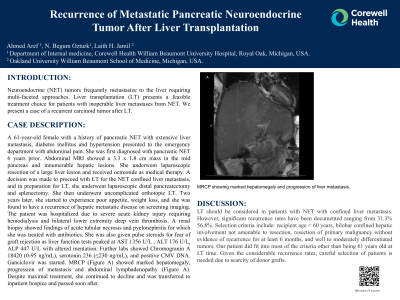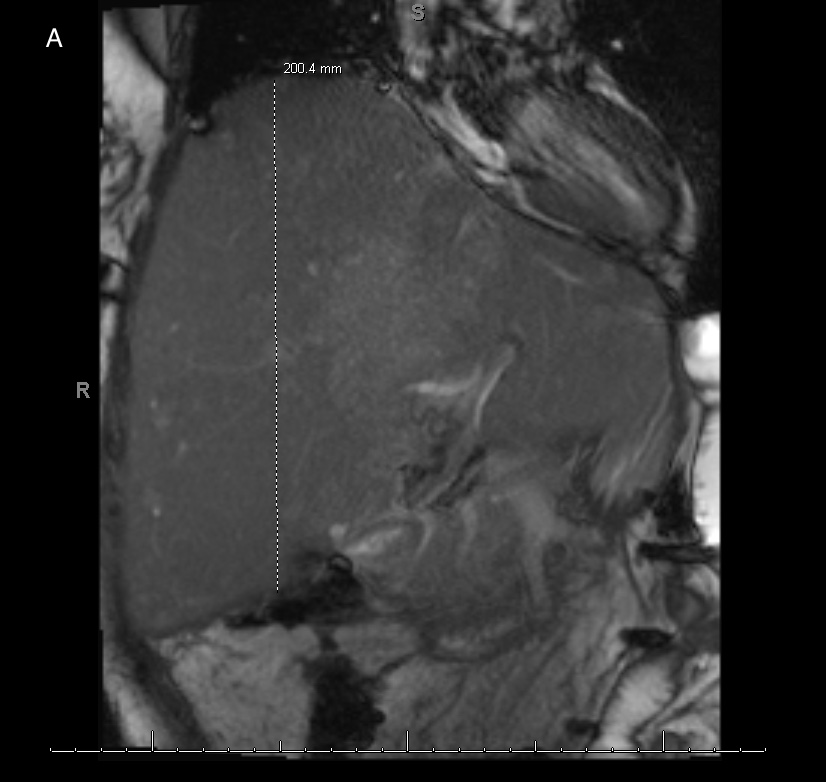Monday Poster Session
Category: Biliary/Pancreas
P1849 - Recurrence of Metastatic Pancreatic Neuroendocrine Tumor After Liver Transplantation
Monday, October 28, 2024
10:30 AM - 4:00 PM ET
Location: Exhibit Hall E

Has Audio
- AA
Ahmed Aref, MBBCh
Corewell Health William Beaumont University Hospital
Royal Oak, MI
Presenting Author(s)
Ahmed Aref, MBBCh1, Nazli Begum Ozturk, MD1, Laith H. Jamil, MD2
1Corewell Health William Beaumont University Hospital, Royal Oak, MI; 2Oakland University William Beaumont School of Medicine, Royal Oak, MI
Introduction: Neuroendocrine (NET) tumors frequently metastasize to the liver requiring multi-faceted approaches. Liver transplantation (LT) presents a feasible treatment choice for patients with inoperable liver metastases from NET. We present a case of a recurrent carcinoid tumor after LT.
Case Description/Methods: A 61-year-old female with a history of pancreatic NET with extensive liver metastasis, diabetes mellitus and hypertension presented to the emergency department with abdominal pain. She was first diagnosed with pancreatic NET 6 years prior. Abdominal MRI showed a 3.3 x 1.8 cm mass in the mid pancreas and innumerable hepatic lesions. She underwent laparoscopic resection of a large liver lesion and received octreotide as medical therapy. A decision was made to proceed with LT for the NET confined liver metastasis, and in preparation for LT, she underwent laparoscopic distal pancreatectomy and splenectomy. She then underwent uncomplicated orthotopic LT. Two years later, she started to experience poor appetite, weight loss, and she was found to have a recurrence of hepatic metastatic disease on screening imaging. The patient was hospitalized due to severe acute kidney injury requiring hemodialysis and bilateral lower extremity deep vein thrombosis. A renal biopsy showed findings of acute tubular necrosis and pyelonephritis for which she was treated with antibiotics. She was also given pulse steroids for fear of graft rejection as liver function tests peaked at AST 1356 U/L , ALT 176 U/L, ALP 447 U/L with altered mentation. Further labs showed Chromogranin A 18420 (0-95 ng/mL), serotonin 236 (≤230 ng/mL), and positive CMV DNA. Ganciclovir was started. MRCP showed marked hepatomegaly, progression of metastasis and abdominal lymphadenopathy (Figure A). Despite maximal treatment, she continued to decline and was transferred to inpatient hospice and passed soon after.
Discussion: LT should be considered in patients with NET with confined liver metastasis. However, significant recurrence rates have been documented ranging from 31.3% 56.8%. Selection criteria include: recipient age < 60 years, bilobar confined hepatic involvement not amenable to resection, resection of primary malignancy without evidence of recurrence for at least 6 months, and well to moderately differentiated tumors. Our patient did fit into most of the criteria other than being 61 years old at LT time. Given the considerable recurrence rates, careful selection of patients is needed due to scarcity of donor grafts.

Disclosures:
Ahmed Aref, MBBCh1, Nazli Begum Ozturk, MD1, Laith H. Jamil, MD2. P1849 - Recurrence of Metastatic Pancreatic Neuroendocrine Tumor After Liver Transplantation, ACG 2024 Annual Scientific Meeting Abstracts. Philadelphia, PA: American College of Gastroenterology.
1Corewell Health William Beaumont University Hospital, Royal Oak, MI; 2Oakland University William Beaumont School of Medicine, Royal Oak, MI
Introduction: Neuroendocrine (NET) tumors frequently metastasize to the liver requiring multi-faceted approaches. Liver transplantation (LT) presents a feasible treatment choice for patients with inoperable liver metastases from NET. We present a case of a recurrent carcinoid tumor after LT.
Case Description/Methods: A 61-year-old female with a history of pancreatic NET with extensive liver metastasis, diabetes mellitus and hypertension presented to the emergency department with abdominal pain. She was first diagnosed with pancreatic NET 6 years prior. Abdominal MRI showed a 3.3 x 1.8 cm mass in the mid pancreas and innumerable hepatic lesions. She underwent laparoscopic resection of a large liver lesion and received octreotide as medical therapy. A decision was made to proceed with LT for the NET confined liver metastasis, and in preparation for LT, she underwent laparoscopic distal pancreatectomy and splenectomy. She then underwent uncomplicated orthotopic LT. Two years later, she started to experience poor appetite, weight loss, and she was found to have a recurrence of hepatic metastatic disease on screening imaging. The patient was hospitalized due to severe acute kidney injury requiring hemodialysis and bilateral lower extremity deep vein thrombosis. A renal biopsy showed findings of acute tubular necrosis and pyelonephritis for which she was treated with antibiotics. She was also given pulse steroids for fear of graft rejection as liver function tests peaked at AST 1356 U/L , ALT 176 U/L, ALP 447 U/L with altered mentation. Further labs showed Chromogranin A 18420 (0-95 ng/mL), serotonin 236 (≤230 ng/mL), and positive CMV DNA. Ganciclovir was started. MRCP showed marked hepatomegaly, progression of metastasis and abdominal lymphadenopathy (Figure A). Despite maximal treatment, she continued to decline and was transferred to inpatient hospice and passed soon after.
Discussion: LT should be considered in patients with NET with confined liver metastasis. However, significant recurrence rates have been documented ranging from 31.3% 56.8%. Selection criteria include: recipient age < 60 years, bilobar confined hepatic involvement not amenable to resection, resection of primary malignancy without evidence of recurrence for at least 6 months, and well to moderately differentiated tumors. Our patient did fit into most of the criteria other than being 61 years old at LT time. Given the considerable recurrence rates, careful selection of patients is needed due to scarcity of donor grafts.

Figure: MRCP showing marked hepatomegaly and progression of liver metastasis.
Disclosures:
Ahmed Aref indicated no relevant financial relationships.
Nazli Begum Ozturk indicated no relevant financial relationships.
Laith Jamil indicated no relevant financial relationships.
Ahmed Aref, MBBCh1, Nazli Begum Ozturk, MD1, Laith H. Jamil, MD2. P1849 - Recurrence of Metastatic Pancreatic Neuroendocrine Tumor After Liver Transplantation, ACG 2024 Annual Scientific Meeting Abstracts. Philadelphia, PA: American College of Gastroenterology.
